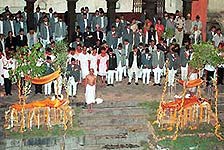 |
|
|
|
 |
|
|
|
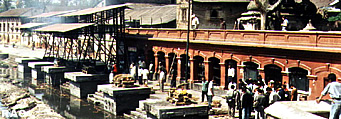 |
| Funeral June 02, 2001 |
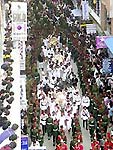 |
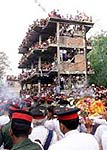 |
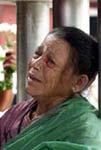 |
|
|
Speculation
rife over happenings on Friday night Kathmandu, June 03 , 2001 |
| In the first official admission that King Birendra and seven other members of the Nepal royal family died of gunshot wounds, Prime Minister G P Koirala and Prince Gyanendra said in separate statements that the tragedy occurred when an automatic riflewent off accidentally. However, they did not mention who fired the shots. |
| The
official radio and television stations only spoke of the demise of King
Birendra and Queen Aishwarya, without mentioning the cause of the death.
The marked absence of the commander-in-chief of the Royal Nepal Army, General
Rana, from Saturday's cremation of King Birendra and the failure of the
official media to mention his name in any context since Friday's brutal
massacre at the royal palace is leading to speculation about whether the
General's exclusion is linked in any way to the events leading up to the
assassination of the late king. General Rana was not present at the
sitting of the Raj Parishad, or Privy Council, which declared crown prince
Dipendra as the new king.
The absence of General Rana and the failure of the government to give a digestible version of the incident make it imperative for parliament to convene and demand that the full facts be placed before it. Many here are appalled at the lack of official information about the incident even 48 hours after it occurred. People have a right to know. The weekly Nepali language newspaper Himal Khabarpatrika brought a special bulletin Sunday morning with a full account of the events at the Royal Palace on Friday night. All other local newspapers continued to play safe, reporting only the official version with some minor embellishments. |
|
Late
King Birendra's legacy Kathmandu, June 03 , 2001 |
| The late King Birendra was sincerely interested in Nepal's development, as displayed by his attempts atreforming the education sector, and the social system. The late king's division of the country into five development regions, amajor development initiative, was designed specifically to improve the lives of the people of neglected west Nepal. |
|
King Birendra ascended the throne on 31 January 1972 but was only crowned on 28 February 1975. In 1980, five years afterthe late king inherited the partyless Panchayat system from his father King Mahendra, he put it to test in a referendum, inwhich people voted in favour of continuing the panchayat system with reforms. He enjoyed absolute power until 1990 when a popular movement toppled the system and restricted the power of the monarch. In the last 11 years the king earned a lot of respect at home and abroad, and was commended by political parties for supporting democracy.One of King Birendra's biggest achievements was his role in forming the South Asian Association for Regional Co-operation (SAARC). He is credited by many with taking the initiative in creating South Asia's biggest co-operation alignment. However his foreign policy initiative to declare Nepal a Zone of Peace was abandoned without explanation by successive governments after the restoration of multi-party democracy despite the support of 116 countries, excluding India. The king pushed for friendly ties with immediate neighbours China and India.King Birendra's love for his country and people was openly displayed in his numerous visits to different parts of the kingdom.The king, a paratrooper and an experienced helicopter pilot, had flown or travelled by foot to many parts of the country. During the Panchayat era he paid annual regional visits setting up camp at the five regional district headquarters to get a firsthand knowledge of local problems and issues; the practice was discontinued after 1990.The king was a widely travelled man and established personal rapport with world leaders who have mourned his death. |
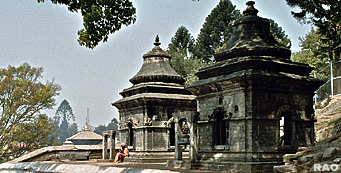 |
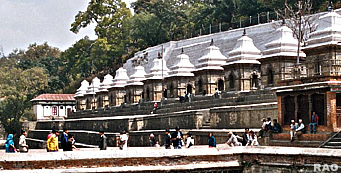 |
| Pashupathinath | Pashupathinath |
|
Royal
Family: A profile Kathmandu, June 03 , 2001 |
His
Late Majesty King Birendra
Born on 28 December,1945 to His Late Majesty King Birendra was the first son of His late Majesty King Mahendra Bir Bikram Shah Dev and Late Crown Princess Indra Rajya Laxmi Devi Shah. His Late Majesty King Birendra ruled the Kingdom of Nepal as an autocratic monarch for 19 years . His Late Majesty acquired his early education at St. Joshep's School, Darjeeling and higher education at Eton College, England, (1959-1964), University of Tokyo (Japan) and Harvard University (USA), (1967-1968).
His Late Majesty King Birendra was married to Her Majesty Queen Aishwarya Rajya Laxmi Devi Shah and was declared Heir-Apparent to the throne of Kingdom of Nepal, in 1970. At the 'Coming-of-Age' Ceremony he was conferred the title of Grand Master of all orders of the Kingdom of Nepal and Colonel-in-Chief of Royal Nepalese Army in 1964. His Majesty the King ascended the throne in 1972.
King Birendra, was the patron of Royal Nepal Academy of Science and Technology, King Mahendra Trust and Pashupati Area Development Trust. His Majesty was also the Chancellor of Tribhuvan University and Mahendra Sanskrit University.
His Majesty the King had announced the referendum and asked whether the people wanted the multi-party system or the party-less Panchayati system. King Birendra announced Nepal as a democratic country in 1990 after a popular movement.
Her
Late Majesty Queen Aishwarya
Daughter of Late Lieutenant General Kendra Shumsher Rana and Shree Rajya Laxmi Rana, Late Queen Aishwarya Rajya Laxmi Devi Shah was born in November 1949 in the Capital. Her Late Majesty acquired early education at St. Helen's Convent, Kurseong, (India) and St. Mary's High School, Kathmandu. Queen Aishwarya acquired higher education from Tribhuvan University in 1967.
Her Late Majesty the Queen was married to His Majesty King Birendra Bikram Shah Dev in 1970. Queen Aishwarya was a patron of International Women's Year Committee in 1975, Chairperson of Social Service National Coordination Council, (1977-1989) and was the Chief Patron of Nepal Red Cross Society. Her Majesty the Queen used to enjoy reading literature, gardening and music as hobbies. Her Majesty the Queen has written several poems and lyrics under the penname Chandani Shah. Queen Aishwarya used to accompany His Majesty the King on most of His Majesty's visit abroad.
His
Late Royal Highness Prince Nirajan
Younger Son of Their Late Majesties King Birendra and Queen Aishwarya, Prince Nirajan was born on 6 Nov, 1978 at Narayanhiti Royal Palace. His Late Royal Highness Prince Nirajan acquired his early education from Kanti Ishwori Shishu Vidhyalaya and got admitted to Budhanilkantha Boarding Secondary School in 1987. Prince Nirajan was pursuing his higher education at Kathmandu College of Management (Bachelor in Business Studies).
Her
Late Royal Highness Princess Shruti
Born on 16 Oct, 1976, Narayanhiti Royal Palace Her Royal Highness Princess Shruti Rajya Laxmi Devi Shah was a daughter of Their Late Majesties King Birendra Bir Bikram Shah Dev and Queen Aishwarya Rajya Laxmi Devi Shah. Princess Shruti was married to Gorakh Shumsher JBR in 1998. Her Royal Highness acquired her early education from St. Mary's High School and was pursuing her BA level studies in Kathmandu. Princess Shrurti got decorated with Suprasiddha Prabal Gorkha Dakshina Bahu I on Dec 29, 1995.
 |
| Pashupathinath |
|
|
